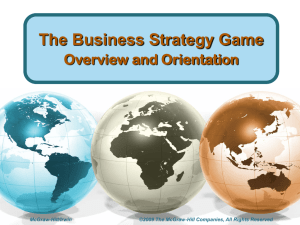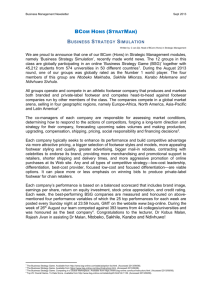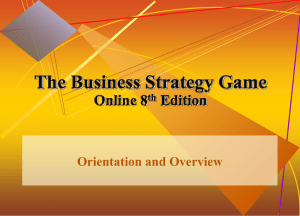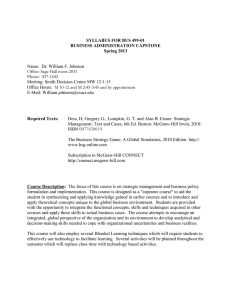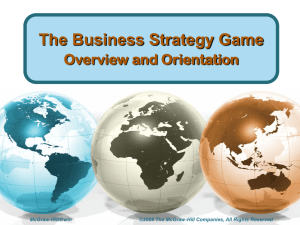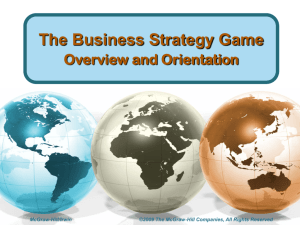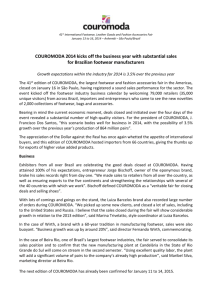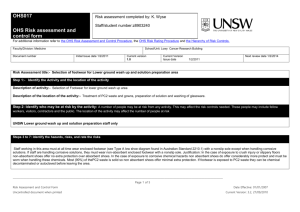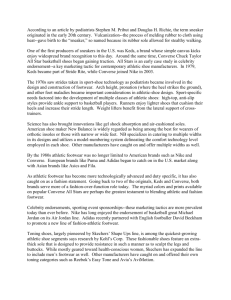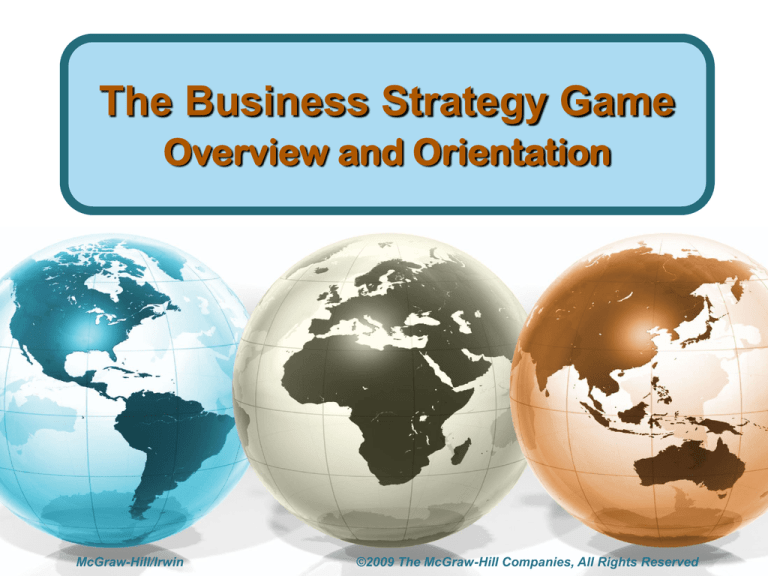
The Business Strategy Game
Overview and Orientation
McGraw-Hill/Irwin
©2009 The McGraw-Hill Companies, All Rights Reserved
What Is The Business
Strategy Game All About?
It’s an online, PC-based exercise where you
run an athletic footwear company in head-tohead competition against companies run by
other class members.
The marketplace is worldwide—production
and sales activities can be pursued in North
America, Latin America, Europe-Africa, and
Asia Pacific
There are 12 market segments—4
geographic segments each for branded
footwear sales to retailers, for online footwear
sales direct to consumers, and for privatelabel sales
1-2
Your Company’s Situation
All companies start out on the same footing—with
equal sales volume, global market share, revenues,
profits, costs, footwear quality, and so on.
Each decision period in The Business Strategy
Game represents a year.
The company you will be running began operations
10 years ago, and the first set of decisions you and
your co-managers will make is for Year 11.
The company had Year 10 revenues of $238 million,
net profits of $25 million (equal to $2.50 per share),
an ROE of ~17%, and a solid B+ credit rating.
Your company is in sound financial condition, is
performing well, and its products are well-regarded
by the buyers of athletic footwear.
1-3
The Decisions You Will Be Making
You and your co-managers will make decisions
each period relating to
Corporate social responsibility and citizenship
Production of branded and private-label athletic
footwear (maximum of 4 plants)
Plant capacity additions/sales/upgrades
Worker compensation and training
Shipping
Pricing and marketing
Bids to sign celebrities to endorse your
company’s footwear
Financing of company operations
Plus there is a screen for making annual sales
forecasts and deciding whether to have
inventory clearance sales
1-4
Competition Is Head-to-Head:
Company Against Company
The head-to-head competition among companies
to persuade consumers to buy their brand of
athletic footwear is based on 10 factors:
Price
Number of models/styles
Styling/quality (S/Q) rating
Advertising
Size of retailer network
Celebrity endorsements
Delivery time
Retailer support
Mail-in rebates
Shipping charges (Internet sales only)
1-5
You Have Many Strategic Options
Company managers have wide strategic latitude in
staking out a market position and striving for good
performance. There’s no built-in bias that favors any
one strategy.
Companies can pursue a competitive advantage
keyed to low-cost/low-price or top-notch footwear
features and styling or more value for the money.
Companies can have a strategy aimed at being the
clear market leader in (a) selling branded footwear
to retailers or (b) selling directly to online buyers or
(c) both.
Companies can put as little or as much emphasis
on producing private-label footwear as
management prefers.
Companies can focus on one or two geographic
regions or strive for geographic balance.
Companies can pursue essentially the same
strategy worldwide or craft slightly or very different
strategies for each geographic region.
1-6
No One Strategy Is “Best”
Most any well-conceived, well-executed
competitive approach is capable of
succeeding, provided it is not overpowered
by the strategies of competitors or defeated
by the presence of too many copycat
strategies that dilute its effectiveness.
In other words, which strategies deliver the
best performance hinges on the strength
and interplay of each company’s strategy
and decisions against the strategies and
decisions employed by rival companies—
there positively is no mystery “silver bullet”
strategy or decision combination that
players are challenged to discover.
1-7
A Company’s Competitive Effort
vis-à-vis Rivals Is Crucial
All the sales and market share differences
among companies are attributable to differing
competitive efforts on price, S/Q rating,
advertising, models offered, delivery times,
retailer support, and so forth.
Hence, every company’s strategic challenge is
to craft a competitive strategy (consisting of its
prices, S/Q ratings, advertising, models,
delivery times, retailer support, and so on) that
it believes will produce the desired sales and
market share outcomes when pitted against the
competitive strategies of rival companies,
region by region.
1-8
The Contest in the Marketplace Is a
“Battle of Strategies”
Following each year’s decisions, you’ll be
provided with Competitive Intelligence reports
containing information of the actions rivals took
to capture the sales and market shares they got.
Armed with this information, you will be in
pretty good position to figure out some of the
strategic moves that rival companies are likely
to make in the upcoming decision period.
Just as in sports where it is customary for every
team to scout its next opponent thoroughly and
develop a game plan to defeat them, you will
need to scout the strategies of rivals, try to
judge what they will do next, and come up with
a competitive strategy of your own aimed at
“defeating” their strategies and boosting your
company’s performance.
1-9
Outcompeting Rivals Is the Key
to Market Success
You’ll have to stay on top of changing market
and competitive conditions, try to avoid being
outmaneuvered and put into a competitive bind
by the actions and maneuvers of rival
companies, and make sure your footwear is
attractively priced and competitively marketed.
Just as you are trying to win business away
from rival companies, some or all rivals are
certain to be actively striving to take sales away
from your company.
It is the competitive power of your strategy vis-
à-vis the competitive power of rivals’ strategies
that is the deciding factor in determining sales
and market shares.
1-10
It’s All About Developing
Winning Strategies
The Business Strategy Game is all about
practicing and experiencing what it takes to
develop winning strategies in a globally
competitive marketplace.
When the exercise is over, the only things
separating the best-performing company
from those with weaker performances will
be the caliber of the decisions and
strategies of the management teams of the
respective companies.
It’s an exercise calculated to spur
competition and to get your competitive
juices flowing.
1-11
Some Features of the Market and
Company Environment
The industry setting in The Business Strategy
Game is modeled to closely approximate the
real-world character of the globally competitive
athletic footwear industry.
The functioning of the marketplace in The Business
Strategy Game mirrors the competitive functioning of
the real-world athletic footwear market, thus allowing
you and your co-managers to proceed rationally and
logically in deciding what to do.
Company operations are designed to be as
realistic as possible
Operations are patterned after those of an athletic
footwear company that makes its footwear at
company-operated plants.
All cause-effect relationships and revenue-cost-profit
relationships are based on sound business and
economic principles.
1-12
Some Features of the Market and
Company Environment (cont.)
The whole concept underlying The Business
Strategy Game is to put you and your comanagers in as realistic a company and
competitive market setting as possible and have
you manage all aspects of the company’s
operations
This allows you to test your ideas about how
to run a company in a competitive
marketplace
And you will be provided prompt and
detailed feedback on the outcomes of your
decisions.
1-13
PC Requirements and Mechanics
Virtually all BSG activities take place online, on a PC
that must be installed with both Internet Explorer and
Microsoft Excel (either the 2000, XP, 2003, or 2007
versions).
You can either use the same PC for all BSG sessions
or you can use different PCs; all that is required is an
Internet connection, Internet Explorer, and Microsoft
Excel.
BSG-Online automatically transfers the needed
software from the BSG server to the PC you are
working on very quickly (within a couple of minutes
even on a slow connection); when you exit a session,
your work is saved and transferred back to the server.
The last decisions saved to the BSG server at the time of
the decision deadline are the ones used to generate
the results.
1-14
How Company Performance Is Judged
Board members and shareholders/investors have
set five performance objectives for the company:
1. Grow earnings per share at least 7% annually
2.
3.
4.
5.
through Year 15 and at least 5% annually
thereafter.
Maintain a return on equity investment (ROE) of
15% or more annually.
Maintain a B+ or higher credit rating.
Achieve stock price gains averaging about 7%
annually through Year 15 and about 5%
annually thereafter.
Achieve an “image rating” of 70 or higher (a
company’s image rating is tied to the styling/quality
of a company’s branded footwear, market share
penetration, and its actions to display corporate
citizenship and social responsibility).
1-15
Scoring Weights
The weights that will be placed on your
company’s achievement of each of the five
annual performance targets are as follows:
EPS
ROE
Credit Rating
Stock Price
Image Rating
10%
10%
30%
25%
25%
Note this is a change from the manual
1-16
The Two Scoring Standards
Two scoring standards are used in calculating
“performance scores” for each company:
The investors expectations standard (Did
you meet or beat the annual performance
targets for each of the 5 performance
measures?)
The best-in-industry standard (How well
does your company’s performance stack up
against the company with the best EPS,
ROE, stock price, and image rating and
against an industry-best A+ credit rating?)
The scoring standards are explained in the
Player’s Guide and even more fully on the “Help”
screens for pp. 1, 2, and 3 of the Footwear Industry
Report where the company scores are reported.
1-17
The Quiz
There is one “open book” 20 multiple-choice question
quiz built into the exercise. The quiz is taken online and
scored immediately upon completion:
Quiz 1: Covers the Player’s Guide—its purpose is
to spur you to read and absorb how things work in
preparation for managing your company. Time
Limit = 45 minutes.
Click on the links for the quizzes on your
“Corporate Lobby” web page for more
information—the three sample questions for the
quiz give you an idea of what to expect.
1-18
The Peer Evaluations
At the middle, and at the end of the
exercise, you will be asked to complete a
12-question evaluation of each of your comanagers and a self evaluation of your own
performance.
These are completed online and can be
reviewed by clicking on the Peer Evaluation
Link on your Corporate Lobby web page.
The peer evaluations are for your instructor
only and are completely confidential.
1-19
What You Can Expect to Learn
Running the athletic footwear company in head-on competition with
rivals will give you a chance to put into play the very kinds of things
you are reading in the text about crafting and executing strategy in
a globally competitive marketplace—there is a very tight connection
between the text for the course and The Business Strategy Game.
You and your co-managers will have to chart a long-term direction
for your company, set and achieve strategic and financial
objectives, craft a strategy, and adapt it to changing industry and
competitive conditions.
You’ll have to wrestle with a full array of industry statistics,
company operating reports and financial statements, and an
assortment of benchmarking data and competitive intelligence on
what rivals are doing.
You’ll have to match strategic wits with the managers of rival
companies, "think strategically" about your company's competitive
market position, and figure out the kinds of actions it will take to
outcompete rivals.
Learning to do all these things and gaining an appreciation
of why they matter are the heart and soul of courses
in business strategy.
1-20
What You Can Expect to Learn
In addition, The Business Strategy Game is designed
expressly to provide you with an experience that will:
Draw together the information and lessons of prior
courses, consolidate your knowledge about the
different aspects of running a company, and provide a
capstone experience for your business school
education.
Deepen your understanding of revenue-cost-profit
relationships and build your confidence in utilizing the
information contained in company financial statements
and operating reports. You’ll see why you cannot hope
to understand a company’s business and make
prudent decisions without full command of the
numbers—it won’t take you long to appreciate why
shooting from the hip is a sure ticket for managerial
disaster.
Provide you with practice in sizing up a company’s
situation, making sound, responsible business
decisions, and being accountable for delivering good
results.
1-21
How Do You Register and Get Started?
The registration process consists of five steps:
Step 1: Have your assigned company registration
code handy (this code is used to put you into the
database for this specific course and to certify you as
a co-manager of your assigned industry and
company). Your instructor provides this code.
Step 2: Go to www.bsg-online.com
Step 3: Click on the “Create Student Account” button
and enter the company registration code provided by
your instructor in the box.
Step 4: Continue on to the next step of the registration
process where you will need either a credit card or a
Prepaid Access Code that came on a card bundled
with your text.
1-22
Registration Codes
Team A 21955-DNM-A
Team B 21995-DNM-B
Team C 21995-DNM-A
And so on…
1-23
How Do You Register and Get Started?
Step 5: Complete the personal registration
information (user name, password, and so on) and
the credit card payment process (if not using the
Prepaid Access Code on the card bundled with your
textbook). The Web site for credit card payment is
fully secured; you will receive a receipt e-mail. If
you have no credit card or Prepaid Access Code, the
easiest way to complete this step is to arrange to
use a friend’s or co-manager’s credit card and
reimburse them directly with cash or a check.
Once you are registered, you will have full use
of the student portion of the BSG Web site
and access to all of the materials and
information you will need.
1-24
The Corporate Lobby Page
Each time you log-on to www.bsg-online.com, you are
automatically routed to your company’s “Corporate
Lobby” web page.
The Corporate Lobby page is your gateway to all BSG
activities. Near the top of this page is a series of menu
selections that provide instant access to all the necessary
information, materials, and tools you will need:
The Player’s Guide
Decision Schedule
Assignments
Support
Company Name
Below these menu items are (1) a Decisions and Reports
box for accessing the decision entry screens and viewing
reports, (2) a message center box, and (3) information
showing the latest exchange rate adjustments, current
interest rates, and a company performance scoreboard.
You have anywhere, anytime access to your Corporate
Lobby page from any PC that is connected to the Internet.
1-25
Creating a Name for Your Company
Shortly after registering, you and your co-managers
should decide on a name for your athletic footwear
company.
Your company’s name must begin with the letter of
the alphabet that you have been assigned. Names
can be up to 20 characters. To name the company,
click on the Company Name menu item near the top
of the Corporate Lobby screen and enter your
company’s full name in the space provided.
All company names are “public” and appear in the
Footwear Industry Report; thus you should select a
name that you are proud of and that reflects the
image you want to project to your customers,
shareholders, other company stakeholders, and the
general public.
1-26
Some Procedures
Check the Decision Schedule link on your
Corporate Lobby page for the dates and
deadlines for the decisions. The decision
deadlines are strictly enforced, since the results
are processed automatically on the BSG servers
minutes after the deadline.
The results of each decision will be available
after the start of the next class period.
You will be notified via e-mail as soon as the
results are ready. At that point you can log-on,
see what happened, and proceed with the next
decision.
1-27
Tips for Success
Follow the Suggested Decision Procedures (see
the Support menu on your Corporate Lobby page)
Learn as much as you from the practice
decision(s) --- become fully acquainted with all the
menus and how things work on the screens
Make full use of all the “Help” sections for each
decision screen—these provide full explanations
of the factors surrounding each and every
decision entry and provide all kinds of tips and
suggestions to guide your thinking.
Make full use of the “Help” sections for the
Company Reports, the Footwear Industry Report,
and the Competitive Intelligence Reports—these
screens provide essential details of what the
numbers mean, how they are calculated, and how
to use the information to good advantage.
1-28
Tips for Success
Run the company in a serious, professional manner.
The overriding purpose of The Business Strategy
Game is to give you practice in making business
decisions, learning to craft winning strategies in a
competitive market, and being held fully accountable
for the results of your actions—just as managers in
the real-world are held accountable for the
performance of the companies they run.
Be very wary of trying something that is imprudent or
highly risky or un-businesslike (things that would get
a manager fired in a real company).
Students who resort to trying to “game the
system” usually shoot themselves in the foot.
This is not the time to be a daring adventurer out
to win some variant of a videogame by making
wild decisions or extreme decision entries.
1-29
Game Specifics
1-30
Plants
Currently 2M in NA, 4M in Asia
Available in EuroAfrica and Latin America
Tariffs
$8 into Asia
$6 into LA (unless from NA)
$4 in EU
1-31
Distribution
Wholesale market
Online sales
Private label sales
1-32
Demand is Growing
Branded in near years
NA & EU – 5-7%
Asia & LA – 9-11%
Private Label in near years
NA & EU – 10%
Asia & LA – 10%
Intense competitive can increase demand,
weak competition can stifle growth
Demand in the future is uncertain. Future
growth projections will be announced in the
FIR. In general, analysts believe that growth
in demand in the long run will fall.
1-33
Materials Costs
Standard and Superior materials
Select a percentage of each used in each plant
$6 for standard, $12 for superior
e.g. 50/50 would be $9
Price will rise/fall based on demand
If global production rises/falls above/below
110%/905 of global capacity
Costs rise 2% for every 1% use above 50%
Costs fall .5% for every 1% use below 50%
No inventory of material
1-34
Exchange Rate Impacts
Adjustments occur when:
Shoes shipped from one region to another
When sales are made in non-NA markets as all
financials are converted into dollars.
No exchange rate effects in year 11
They will commence afterwards; rates taken
from the most recent close in real financial
markets.
1-35
What Drives Sales In Branded Markets?
Price
S/Q rating
Breadth of product line
Advertising
Mail in Rebates
Celebrity Appeal
Delivery time
Sales Support
Retailers
Effectiveness of online sales
Loyalty
1-36
Implications
There are many ways to compete
There are many levers to pull
The “BEST” strategy is one which
maximizes the combined benefits of these
factors while not spending too much to
obtain their benefit.
1-37
Making Decisions
Each team member has access to your
team’s decisions.
Each of you are logging into the same
decision data.
The last saved decision, from any team
member, is the current set of decisions
1-38
CSR & Citizenship
Green footwear materials
Recycled packaging
Energy efficiency improvements
Charitable contributions
Ethics training/enforcement
Workforce diversity
All of these effect your Company Image
Ongoing efforts gain greater rewards than
token gestures
1-39
Branded Sales Forecast
You MUST make a sales forecast. Sales
forecasts are then used to drive all sales,
cost and revenue projections.
If you are too conservative
You might suffer stockouts and lose potential
sales
If you are too aggressive
You will carry inventory and your costs per unit
will be far higher than anticipated
1-40
Plant Capacity Decisions
No Selling Existing Capacity
Overtime up to 20% additional production
EuroAfrica & LA (add from 1 to 2M)
Takes a year to come online
Add capacity to existing facilities
100K to 50% of existing capacity
Must justify increase
Takes a year to come online
Upgrades
A – Reduces reject rates by 50% ($2.5 per M)
B – Reduced set-up costs by 50% ($8 per M)
C – Boosts SQ by 1 ($7 per M)
D – Increases productivity per worker by 25% ($3.5 per M)
Takes effect year ordered; can’t do during construction
2 upgrades per facility
Expected costs savings per year are shown
1-41
Branded Production Decisions (for each plant)
% of Superior Materials
Models – 50, 100, 150, 200, 250, 350, 500
Higher setup costs
Styling/Feature per model
TQM/Sigma 6 – (0 to 2.50 per shoe capacity)
Each plant gets an S/Q rating each year
Branded market measure is a function of the pro-rated rating of
every shoe in inventory
Shoes from different plants
Shoes remaining in inventory
Production
See page 18 in manual for important explanation
Diminishing returns and current expenditures
1-42
Branded Production Decision (per plant)
Compensation
Raise or lower wages
+2% increases productivity (15% max)
Cuts lower productivity
Incentive per pair produced
Increases productivity (up to 25% of total comp, max at
50%)
Training per employee
Lowers rejects
Improves S/Q
Lowers material waste
Increases productivity
Total compensation relative to others in region
Rejects a function of incentive pay, TQM, training, and styles
1-43
Branded Distribution (for each plant)
Once shoes produced, where will you ship
them?
Factors to consider
S/Q
Delivery times (1-4 weeks)
Avoiding stockouts
Inventory costs ($1/year and 1 S/Q point)
Exchange rates
Shipping to warehouse - $1 in region, $2 across
Shipping to retailers - $2 to $1 per shoe
1-44
Internet Marketing
Price
$150 max
Should try to stay at least 40% wholesale price
Retailers might refuse to stock your shoes
next year
Number of models offered
Max is the minimum models offered in any one
market
$15K for each model offered online
Delivery - $10 or free
SQ, advertising, and celebrities also drive sales
$1.25M to run website
You can block internet sales in any/all markets
1-45
Marketing Decisions
Price
Advertising
Rebates ($1 to $10 per shoe)
High rebates are more often redeemed
Outlets
How many willing
SQ, market share, support, delivery, Internet
price from LAST YEAR
Retailer Support ($100 to $2.5K)
Delivery, 1 to 4 weeks
$0.25, $0.75 cents, $1.50 and $3,00
1-46
Celebrity Bids
Potential to sign celebrities to endorse your
shoes, each with a regional appeal
Payton Manning big in US, not so in Asia
500K minimum
Place cap on total dollars spent
Cancel contracts your paid too much for
Rank order your bidding
Ties go to the team that needs it the most
1-47
Private Label
Private label is a closed bid sales segment
Choose superior usage & styling/features
specification to calculate an S/Q.
Use capacity not dedicated to wholesale
production to make PL shoes
Ship PL shoes to the PL market you wish to
compete in
Choose price (must be $5 below retail price)
Lowest priced lot sold first. Sales continue
until entire demand for PL shoes is fulfilled.
1-48
Finance & Cash Flow
1, 5, 10 year bank loans (7%, 7.5% & 8.0%
base interest rates)
Repayment of loans
Dividends per year
Stock Issue
Stock Repurchase
1-49
SAVE YOUR RESULTS!
1-50
Special Reports
Footwear Industry Report
Competitive Intelligence Reports
Company Reports
1-51
http://www.corvalliscommunitypages.com/How_To_Win_the_BSG_Business_Strategy_Game.htm
Some of the information here is good, right on.
Some of the information is completely flawed
Why?
I’ve changed the weights for scoring
Credit Rating, Stock Price, and Image are more
important than straight returns of EPS and ROE which
tended to reward size
Costs and rates within this industry will change
Tradeoffs between different strategies and choices will
be completely different
I’ve altered the demand weights, and each of the 4
markets has a unique demand curve, which may change
with notice during the game
What was important in other industries might not
necessarily be so here.
1-52
Near Term Schedule
Quiz – Before Oct 8, 11:59PM
Practice Decision 1 – Sunday, Oct 10,
11:59PM
Practice Decision 2 – Tuesday, Oct 12,
11:59PM
Real Decision 1 – Sunday, Oct 17, 11:59PM
1-53

